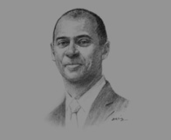OBG talks to Thierry Tanoh, CEO, Ecobank Transnational

Interview: Thierry Tanoh
How can banks take advantage of low rates in order to boost retail growth in the sector?
THIERRY TANOH: With innovations in technology, such as mobile and internet banking, and with attendant changes in regulation, with agency banking as an example, this is probably the most exciting time in recent history for African banks to rapidly increase the banking penetration in hereto unprofitable territories. Resistance to change is the most common obstacle faced in the push to encourage the African community to move their savings away from their homes and into the vaults. The need to have cash constantly to meet simple needs has been an impediment to people who should traditionally be willing to put their cash in banks.
What are the best ways to minimise risk exposure while lending to new African markets?
TANOH: The introduction of credit bureaus in certain key markets, such as Nigeria, Ghana and Kenya, has aided the lending model immensely. We are now in a position to do first order background checks on new prospects. Granted, these credit bureaus are still in their infancy, but as more banks share information with these bureaus, we are likely to see further reduction in non-performing loans as their databases grow exponentially. The key to improving loan-loss provisioning is discipline. Banks should make sure that all exceptions to standard loan applications are well documented, regular reviews of the credit are granted to ensure that the funds are clearly being used for the purposes outlined, and also allow for a third party review of credit files to see if industry best practices are being followed.
At what point is an acquisition strategy preferable to organic growth, when entering a new market?
TANOH: Each market is unique. If the economics of an acquisition strategy supersede that of organic growth, then it makes sense to pursue the acquisition. The same logic applies in reverse and the key to entering a new market is to be flexible in terms of which model to use.
To what extent is providing intra-African trade financing an attractive opportunity for banks?
TANOH: Ecobank prides itself on being the preeminent African trade bank. Our unique geographic footprint means that we are on the sending and receiving sides of many transactions that occur within African trade corridors. With African intra-regional trade at less than 15%, compared to over 80% in the EU and NAFTA, there is significant room for growth, and we will continue to position ourselves to facilitate these exchanges.
How can the increasing demand for trade finance and asset management services be harnessed?
TANOH: Commercial banks can capitalise on increasing demand for trade finance and asset management services by procuring larger trade lines from Development Finance Institutions. This can be done by providing advisory services to new entrants to Africa, like Asian and Australian investors, who are heavily engaged in African trade, especially in commodities and heavy minerals. The growing middle class in Africa also presents opportunities, as prosperity has fuelled the rise of pension funds, social security and sovereign wealth funds. These institutions need safe, profitable asset classes in which to invest surplus funds. Commercial banks are well suited to create the asset classes – like inflation-linked bonds and commercial paper – that form the bulk of these funds’ investments.
How has regulation affected long-term financing in the West African Economic and Monetary Union?
TANOH: The removal of the portfolio structure ratio is not expected to have a significant impact on market players. Only a handful of banks in the region were able to comply and it is not expected to negatively affect Ecobank affiliates. In contrast, lowering the threshold of the medium to long-term deposits ratio could greatly increase firms’ access to long-term financing. For the same level of stable funds, including capital, banks will be able to extend long-term funding to their customers.
You have reached the limit of premium articles you can view for free.
Choose from the options below to purchase print or digital editions of our Reports. You can also purchase a website subscription giving you unlimited access to all of our Reports online for 12 months.
If you have already purchased this Report or have a website subscription, please login to continue.

